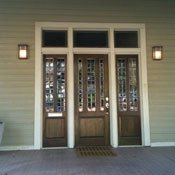As Betty Lyons rode through neighborhoods in west Jackson during a recent tour, she envisioned the boarded-up homes along Grand Avenue and Rose Street occupied with residents and creating a vibrant community.
Lyons, 66, has lived in west Jackson since 1961 and is among a dedicated group of residents who want to see their neighborhoods restored after decades of blight. On Nov. 13, Lyons and about 50 others attended the "WESToration Initiative" tour to learn more about the Federal Housing Administration 203(k) program, aimed at facilitating the purchase of houses that need repairs or modernizing.
Typically, a homebuyer seeking to repair an older home has to acquire three separate loans: an initial mortgage to complete the purchase, separate financing for renovations and a permanent mortgage once the repairs are complete. The 203(k) program bundles financing for the acquisition and renovations together, giving buyers a lower interest rate than they would have otherwise.
Lyons, who lives in Presidential Hills Park next to Jackson State University, said she went on the tour because she is looking for funds to restore her home. In addition to the FHA program, several homes in west Jackson could also qualify for historic tax credits.
"I don't want to leave my neighborhood; I just want to upgrade it," Lyons said.
Jackson State University's Center for University-Based Development Program Manager Curnis Upkins and Director Kimberly Hilliard organized the tour along with mortgage financing expert Bo Smith from Cornerstone Home Lending Inc.
The 203(k) loan can cover energy-efficiency improvements, room additions and painting but not luxury improvements. While several investors attended the tour, the program is designed specifically to bring residents into an area. Homeowners must live at the property for the majority of the year once restoration is complete.
The tour started at Koininia Coffee House and showcased homes on Grand Avenue, Buena Vista Boulevard, West Valley Street and Pecan Boulevard. Mississippi Department of Archives Architectural Historian Todd Sanders also attended the tour.
The van stopped at a white boarded-up cottage on Rose Street. "Looking past cosmetics, this is a good house that just needs to be restored," Sanders said. "You can't get the material that these houses are made of anymore."
Even though most of the homes look as though they should be condemned, Sanders said they are actually built from better materials than modern homes. In today's homes, wood no longer comes from tree farms that use a "slow growth" method that gives the wood more strength and durability.
Several of the houses range from $5,000 to $10,000, and Upkins estimates they need about $60,000 to $80,000 in renovations.
Sanders said a person must have a vision for the home's potential.
"The problem is a lot people aren't able to see past peeling paint, (broken out) windows and overgrown yards and see the beauty that is there," he said, pointing to a home selling for $12,000. "You couldn't even begin to buy the material in that house for $12,000."
The 203(k) program dates back to 1978 but had seen little use until recently. The number of HUD-approved 203(k) loans rose from roughly 3,400 in 2007 to around 22,000 last year, Smith said.
Cornerstone has issued 43 loans through the 203(k) program in Jackson this year.
Upkins, who lives in the Pecan Park neighborhood, said west Jackson needs residents to help restore vacant properties.
"We want to see people living in these vacant properties to make it safer. It's much better to have a family next door than to have an abandoned home," he said.


